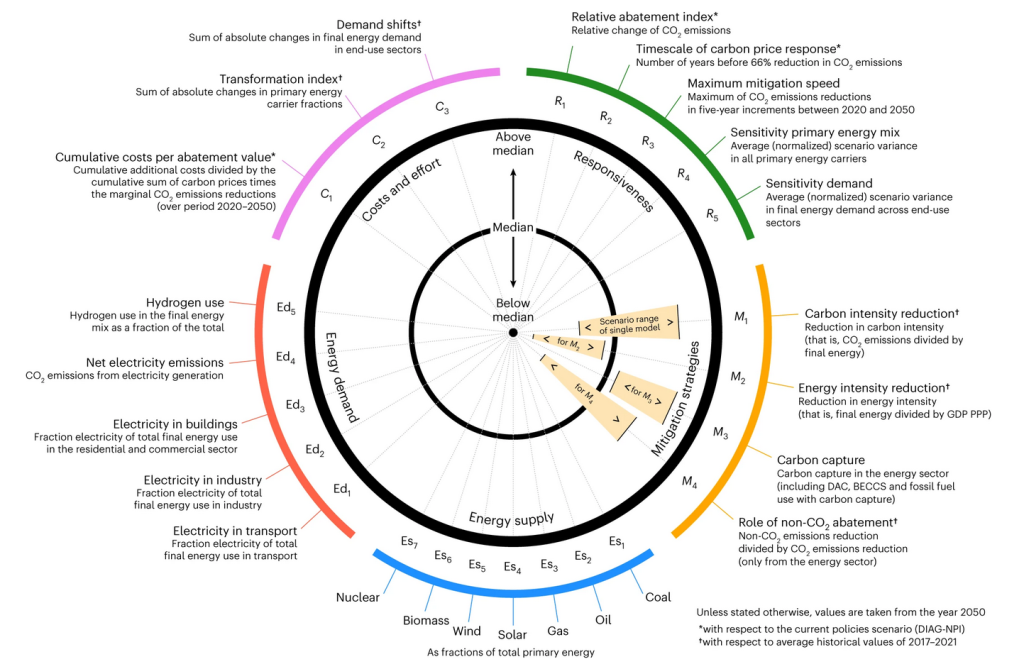Energy model 'fingerprints' in mitigation scenarios
Climate policy is often based on complex energy models. A new paper in Nature Energy proposes ‘model fingerprints’ as a new method to better compare the behaviour of these models. These snapshots of model behaviour allow researchers and policymakers to better interpret results from particular models. This is particularly important when using individual model results to inform policy choices on specific energy technologies, researchers from PBL Netherlands Environmental Agency say.
Energy models are crucial to understand emission mitigation pathways and the feasibility of climate targets. They provide long-term future scenarios for human energy consumption and production. These models are typically used to calculate energy pathways for different climate scenarios on a global scale and lay the groundwork for IPCC reports. It is well established that different models yield slightly different outcomes. While for atmospheric models it is common practice to structurally characterize differences in model behaviour, for energy models this is less common.
‘Fingerprint’ describes model characteristics
Therefore a European research team, including several PBL-researchers set out to create model ‘fingerprints’ describing how each individual model behaves compared to others. These ‘model fingerprints’ are unique overviews of model behaviour at a single glance, much like a fingerprint (or DNA) can be used to unique identify an individual. It is important for policymakers to know how to interpret results from particular models.
Influential models characterized
The researchers set out to characterize eight models, including some of the most influential energy models such IMAGE (PBL), REMIND (Potsdam Institute) and MESSAGE (IIASA). To do so, they ran a set of extreme mitigation scenarios designed specifically to identify characteristic model behaviour. These scenarios included strong limitations on the availability of either biomass, CCS or nuclear energy, as well scenarios with cheap electricity, cheap hydrogen and high energy saving.
Differences in responsiveness to carbon prices and technology adoption
They measured model behaviour using diagnostic indicators across 5 categories: model responsiveness, mitigation strategies, energy supply, energy demand and mitigation costs and effort. Even though there are many similarities in the model outcomes the fingerprints show where and how models differ - notably in responsiveness to carbon prices, speed of uptake of particular energy technologies and the degree of electrification.

Beware of using one single model
It is good that models use different approaches, because relying on a single approach for all models follow would create structural uncertainties and potential bias. Therefore, when using the results for specific technologies from any particular model one should be aware of how that particular models compares to the whole set. ‘This paper indicates that studies using only single models should always be interpreted in the context of the larger model ensemble. This novel concept of fingerprints shows how individual models can be more inclined to favour, say, high quantities of solar panels or CCS,’ says lead author Mark Dekker of PBL. Knowing a model’s fingerprint helps interpreting results from any particular model.
For this research, PBL collaborated with 15 partners from 9 countries including KTH Royal Institute of Technology, CMCC, IIASA, PIK, TU Wien, e-think, TNO, Fraunhofer ISI, E3M, PBL, Artelys, Comillas, TU Delft, University of Melbourne, and IOS-PIB. The research was part of the ECEMF project, funded by the European Union's Horizon 2020 research and innovation program.
- Artikel | 6 November 2023to the publication on the PBL website